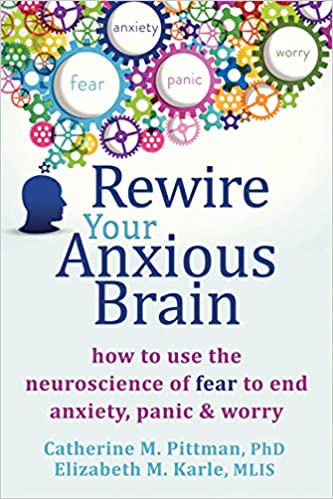Rewire Your Anxious Brain — Book Summary
Introduction
Everybody on this planet feels anxious at one point or the other. The magnitudes differ from person to person. In this book, you will learn about two parts of the brain that are responsible for anxiety. You will also learn about the ways to tackle and reduce your anxiety. There are different triggers for different people and you will learn how to manage yourself better. The two parts of the brain that cause anxiety are cortex and amygdala. You will understand different ways of the coping mechanism when either of the parts of your brain causes anxiety.
Interesting quotes from the book
In the past two decades, research has revealed that the brain has a surprising level of neuroplasticity, meaning an ability to change its structures and reorganize its patterns of reacting.
— Catherine M. Pittman , Rewire Your Anxious Brain
the brain is hardwired to allow the amygdala to seize control in times of danger. And because of this wiring, it’s difficult to directly use reason-based thought processes arising in the higher levels of the cortex to control amygdala-based anxiety. You may have already recognized that your anxiety often doesn’t make sense to your cortex, and that your cortex can’t just reason it away.
— Catherine M. Pittman , Rewire Your Anxious Brain
Thanks to the influence of your cortex, you can decide not to physically fight your boss if you feel you’re in danger of being fired, or choose not to run away when you hear exploding fireworks.
— Catherine M. Pittman , Rewire Your Anxious Brain
Summary of the book Rewire Your Anxious Brain
There are two neural pathways in your brain that cause anxiety and they are:
- The cortex pathway: If you feel your anxiety is because of thoughts, images, and out-of-control ideas along with doubts, then you are probably facing cortex based anxiety.
- Amygdala Pathway: The amygdala pathway creates a physical reaction to anxiety-like sweating, increased heart rate, etc. Amygdala pathway is involved in both cortex based anxiety and amygdala based anxiety
It is important to understand amygdala based anxiety as it is present in both cases. Amygdala tries to protect you from any possible danger. However, in many cases the response is wrong. You can reduce your anxiety by convincing your cortex that the situation is not dangerous. However, this does not work in every case and you should use breathing techniques to calm yourself. It is important to control amygdala anxiety as it affects other parts of the brain and interrupts normal body functions. The amygdala takes control of the body as well as the brain when it feels you are in danger. There are different ways in which anxiety is caused. Amygdala can be triggered by images or thoughts from different hemispheres of the brain. Once you recognize what causes your anxiety, you can use the right set of techniques to calm it down. The key to rewiring your brain is to identify the right techniques.
You need to identify which part of your brain is responsible for your anxiety because different sets of techniques have to be used to calm it. You might feel cortex based anxiety that is caused by specific thought processes. You might feel amygdale based anxiety that is caused by unexplained reasons, inability to think clearly, or extreme responses. You can feel both cortex and amygdale based anxiety also. Once you identify what causes your anxiety, you can choose the specific techniques that are made for each pathway.
There are different ways to ease panic when it comes to amygdala based anxiety, for example deep breathing, muscle relaxation, and exercise. Always remember it is feeling and you can distract yourself from them. Do not focus on your panic attack and let go of any concerns about what other people think about you. Amygdala response is shown in a fight, flight, or freeze response. You need to know that amygdala anxiety can be trained to respond in a better way. Slow, deep breathing helps to reduce anxiety. There are different muscle focused strategies that you can practice like doing a muscle tension inventory, exploring tension vs relaxation, or progressive muscle relaxation techniques. You can even design your own strategies for muscle relaxation to reduce anxiety. Meditation including mindfulness is one of the best ways to control amygdale anxiety. The main aim of all these techniques is to activate the parasympathetic nervous system. Slower breathing and relaxed muscles send a signal to the amygdala that the body is calming down and the body reduces anxiety.
You need to understand your triggers. Triggers are stimuli that start a stress response in the body which activates the amygdala. It can be any sensation, fear, object, or event. Triggers can even be sights, smells, sounds, or situations. Identifying your triggers will help you teach your amygdale. You should try to activate your amygdala through your triggers to expose it to new experiences. It should be a gradual process. You should keep practicing this exposure therapy consistently to reduce your anxiety. In most of the cases, amygdale learns only through experiences and therefore, you need to expose it to new situations. It can be challenging and scary but in the long run, it will help you control your anxiety. It works according to the famous saying "no pain, no gain". To change your fear reaction, it is important to face those situations of which you are scared. Your amygdala will change only if you are ready to put effort.
Your lifestyle choices have a great impact on your brain. You can alter your lifestyle habits by incorporating exercise into your daily routine. Regular aerobic exercises help to improve your mood. Exercise also helps in neuroplasticity that provides agreater chance for your cortex and amygdale to rewire. Getting good quality sleep also helps to make the amygdala less responsive and therefore reduces anxiety.
The third section of this book is based on cortex based anxiety and how to reduce it. Your cortex based thoughts may be activating your amygdala. We all have a different and unique cortex and therefore, everyone has different thoughts. Observe your thought process and be aware of them. You can rewire your cortex to make your lifestyle and mental health better. There are different ways to calm your cortex like cognitive fusion. You can divert your mind to replace your thoughts as you cannot erase them. You should always plan your schedule to avoid worry and panic. Practice mindfulness and other meditations that help to control your mind. Try to take one day at a time and try to think positive.
You are not alone in suffering from anxiety. You can fight it. You need to make yourself a priority and work hard on yourself.
What can we learn from the book Rewire Your Anxious Brain?
Lesson 1: Identify the basis of your anxiety: Amygdala, Cortex, or Both?
You must identify what causes your anxiety so you can treat it accordingly. Amygdala gives physical symptoms like increased heart rate or blood pressure. Cortex based anxiety does not produce any physical symptoms rather it creates thoughts, ideas, or images. There are different techniques to reduce anxiety in both ways so, it is important to know what causes your anxiety. Always remember, there is a way out and you will be all right.
Lesson 2: Teach your amygdale through experiences
You need to make your fears vanish by facing them. It might be difficult and challenging but it will give you a result. Teach your mind how to deal with fear through experience . Once you expose yourself to fear, its effect reduces.
Lesson 3: How to Calm your Cortex
You can replace your thoughts as you cannot escape them. Meditations including mindfulness are extremely useful to help rewire your cortex.
Review of the book Rewire Your Anxious Brain
This book is really helpful for people suffering from anxiety. It helps to relieve worry and teaches you about different techniques that you can practice to live an anxiety-resistant life. This book will make you understand the difference between the two pathways of anxiety. It is informative and explains neurobiology in a very easy way. This book definitely has the potential to change your mindset and lead you towards a better life. It will provide you with different solutions to fight your anxiety and help you gain knowledge about the science behind it.
Conclusion
The book is a must-read for everyone and especially for people battling anxiety. It is informative and will guide you at every step of living a better life. It will help people facing anxiety as it has different exercises and meditations explained in it. I would highly suggest it to people suffering from anxiety to give this book a read. It will help you rewire your brain.
Don't miss the other book summaries on SunInMe.org

